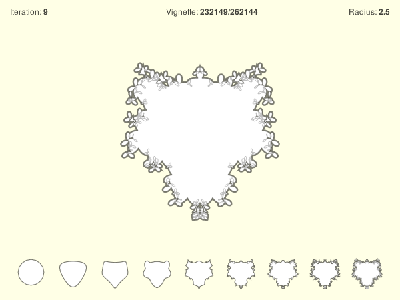No edit summary |
|||
| Line 76: | Line 76: | ||
* Mikko Harju: [https://gist.github.com/mharju/3805082 Unknown Pleasures visualization test with Processing] (2011) | * Mikko Harju: [https://gist.github.com/mharju/3805082 Unknown Pleasures visualization test with Processing] (2011) | ||
----- | |||
== The Meandering Mind == | == The Meandering Mind == | ||
{{ | |||
=== About === | |||
In this lecture we will have look at electric, mechanic, and biological systems and how their trajectories can be analyzed | |||
using data visualisation and sonification | |||
=== Goals === | |||
* motiongrams and motionmaps | |||
* working with EEG, EKG, EMG data | |||
* quantified self | |||
=== Literature === | |||
{{note|Here's some literature that may be relevant for students taking the project module of Ursula Damm:}} | |||
* Edwin R. Lewis: [https://people.eecs.berkeley.edu/~lewis/ProcIEEE68.pdf Using electronic circuits to model simple neuroelectric interactions] (1968) | |||
* Stafford Beer: [https://monoskop.org/images/e/e3/Beer_Stafford_Designing_Freedom.pdf Designing Freedom] (1973) | |||
* Peter Cariani: [http://www.cariani.com/CarianiNewWebsite/Publications_files/PaskDevice93-SelfOrganizingSystems.pdf To evolve an ear: epistemological implications of Gordon Pask's electrochemical devices] (1993) | |||
Revision as of 21:46, 16 September 2016
Meandering Media
Meandering Sound

Martin Schneider: Vignette Explorer (2010)
About
In this lecture we will look at sound signals as meandering curves in time.
- Mathematical Functions — in the 1st part, we will learn how to create curves using mathematical functions.
- Curves of Sound — in the 2nd part, we will learn how to make audible curves in time and space.
Goals
- Basics of mathematical functions
- Polar coordinates
- Harmonic synthesizer
- Sound synthesis in Processing
Literature
- Irvine Whitty: The Harmonograph (1893)
- Joseph Goold: Harmonic Vibrations (1910)
- Tom Greenslade: All about Lissajous Figures (1993)
- Frank A. Farris: Wheels on Wheels on Wheels — Surprising Symmetry (1996)
- Aatish Bhatia: The Math Trick behind MP3s, JPEGs and Homer Simpson's Face (2013)
- Michael Trott: Making Formulas for Everyhing — from Pi to the Pink Panther to Sir Isaac Newton (2013)
- Michael Trott: Using Formulas for Everything — from a Complex Analysis Class to Political Cartoons to Music Album Covers (2013)
Code
- Santiago Ginnobili: Ptolemy and Homer Simpson (2008)
- Martin Schneider: Vignette Explorer (2011)
- Joe Freedman: Cycloid Drawing Machine + Code (2015)
Art
- Steffen Fiedler: Unreliable Machinery (2011)
- Jeroboam Fenderson: Nuclear Black Noise (2013)
Links
- Harmonic Synthsizer and Harmonic Analyser
- Michael McCarthy: Fourier-Curve Tracing the Batman-Curve (2015)
- John Baez and Anita Chodry: The Harmonograph (2016)
- Jeroboam Fenderson: Oscilloscope Music (2016)
Meandering Video
About
In this lecture will consider look at video signals as meandering curves through space and time.
Goals
- video recording technology
- introduction to video art
- scan line algorithms
- functional video transformations
- processing videos with Processing
Literature
- Thomas Dreher: Geschichte der Computerkunst: Videokulturen (2015)
- Jen Christiansen: Pop Culture Pulsar: Origin Story of Joy Division’s Unknown Pleasures Album Cover (2015)
Art
- Rutt-Etra Video Synthesizer (1974)
- Steina and Woody Vasulka: Objects (1978)
- Steina and Woody Vasulka: Transformations (1978)
Code
- Felix Turner: Rutt-Etra-Izer (2011)
- Mikko Harju: Unknown Pleasures visualization test with Processing (2011)
The Meandering Mind
About
In this lecture we will have look at electric, mechanic, and biological systems and how their trajectories can be analyzed using data visualisation and sonification
Goals
- motiongrams and motionmaps
- working with EEG, EKG, EMG data
- quantified self
Literature
Here's some literature that may be relevant for students taking the project module of Ursula Damm:
- Edwin R. Lewis: Using electronic circuits to model simple neuroelectric interactions (1968)
- Stafford Beer: Designing Freedom (1973)
- Peter Cariani: To evolve an ear: epistemological implications of Gordon Pask's electrochemical devices (1993)